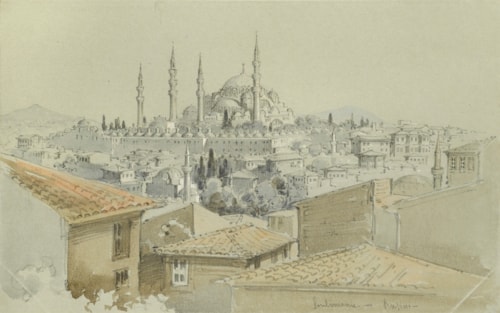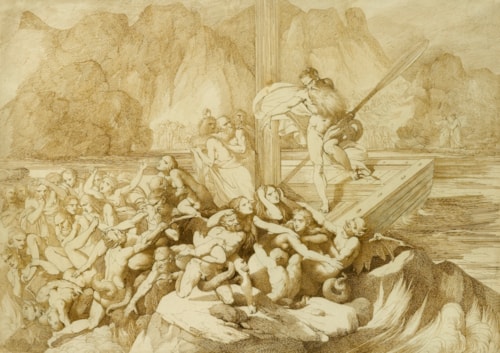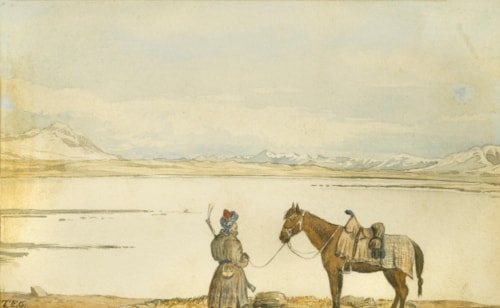lexei Petrovich Bogoliubov
(nr. Novgorod 1824 - Paris 1896)
Hougoumont Farm, Waterloo & Outside Hougoumont Farm
one signed and dated ‘A. Bogoliubov/1870’ (lower right) and inscribed ‘Waterloo fer de Goumont’ (lower left);
the other inscribed ‘F. Goumont.’ (lower left), signed in Cyrillic (lower right)
black and white chalk on paper; gouache and watercolour on paper
56 x 71.5 cm (22⅛ x 28⅛ in); 39 x 50.5 cm (15⅜ x 19⅞ in) (2)
‘Hougomont, -this was a funereal spot, the beginning of the obstacle, the first resistance, which that great wood-cutter of Europe, called Napoleon, encountered at Waterloo, the first knot under the blows of his axe'
- Victor Hugo, Les Miserables, Vol. II, Book I, Chapter II.
In these two works, Alexei Petrovich Bogoliubov depicts Hougoumont Farm, or Château d’Hougoumont, the setting of one of the most vital and decisive conflicts during the Battle of Waterloo (1815). Before the battle commenced, Hougoumont and its gardens were occupied by British forces and Napoleon Bonaparte (1769-1821) attacked at this point throughout the day. Despite the fierce assaults, the farm remained unbowed after nearly nine hours of continuous fighting. 14,000 French troops were sent to try and capture the farm and the loss of such resources is considered to be a major contributing factor in Napoleon’s ultimate defeat. The Duke of Wellington declared afterwards that ‘the success of the battle turned upon the closing of the gates at Hougoumont’.¹ The château itself was burnt to the ground, with only its chapel surviving, in addition to various farm buildings visible in Bogoliubov’s work.
In Hougoumont Farm, Waterloo, Bogoliubov portrays the chapel and courtyard of the farm. The scene still seems to bear the scars of the ferocious fighting, most overtly in the solitary crumbling wall, on the left-hand side of the work. The vast pile of tree trunks and branches are another symbol of death and decay. The deep shadows and silhouettes of identifiable figures all contribute to the morbid mood of the work. In Les Misérables, published eight years before the present work was painted, Victor Hugo (1802-1885) describes his own experiences of visiting Hougoumont writing, ‘the storm of the combat is still in the court: the horror is visible there; the overturn of the conflict is there petrified; it lives, it dies; it was but yesterday. The walls are still in death agonies; the stones fall, the breaches cry out; the holes are wounds; the trees bend and shudder, as if making an effort to escape’.² Hougoumont Farm, Waterloo shares a very similar mood, the farm still bearing the scars of battle.
Outside Hougoumont Farm shows a more distanced view of the farm. This depiction is not focused on the buildings as ravaged by war, but as an isolated feature in a slightly rugged, windswept rural landscape. However, an awareness of the subject’s historical context makes the darkening clouds and the sense of silent isolation infinitely more poignant.
These two ostensibly tranquil scenes have much in common with many of Bogoliubov’s landscape works. His French landscapes in particular, often feature isolated, rustic and slightly dilapidated farm buildings, an example being House in Velay. In this work, the building has a rundown air, with ivy growing wildly over it. Although there is not quite the sense of decay that there is in Hougoumont Farm, Waterloo, Bogoliubov has captured that same sense of history which is a recurring theme throughout much of his work. The feeling of tranquillity that can be found in House in Velay, is even more pronounced in the views of Hougoumont, where Bogoliubov’s use of a strictly monochromatic palette heightens this effect.
Educated in Russia, Bogoliubov then travelled to Europe between 1854 and 1860. In France he made friends with painters of the Barbizon school, such as Camille Corot (1796-1875). On his return to Russia he became one of the most successful and respected of contemporary Russian artists. In 1885, he opened the Radischev Art Museum, the first such institution in Russia to be open to the general public. The present works reflect two of the major influences on Bogoliubov’s art: the Barbizon school, in the realistic and focused depiction of nature, and Ivan Konstantinovich Aivazovsky in his use of a monochrome palette to heighten the poignancy of the scene.
¹ Roberts, A., Waterloo: Napoleon’s Last Gamble (Harper Collins, London, 2005), p. 57.
² Hugo, V., Les Misérables (Wordsworth Editions Ltd., 1994), p. 209.
‘Hougomont, -this was a funereal spot, the beginning of the obstacle, the first resistance, which that great wood-cutter of Europe, called Napoleon, encountered at Waterloo, the first knot under the blows of his axe'
- Victor Hugo, Les Miserables, Vol. II, Book I, Chapter II.
In these two works, Alexei Petrovich Bogoliubov depicts Hougoumont Farm, or Château d’Hougoumont, the setting of one of the most vital and decisive conflicts during the Battle of Waterloo (1815). Before the battle commenced, Hougoumont and its gardens were occupied by British forces and Napoleon Bonaparte (1769-1821) attacked at this point throughout the day. Despite the fierce assaults, the farm remained unbowed after nearly nine hours of continuous fighting. 14,000 French troops were sent to try and capture the farm and the loss of such resources is considered to be a major contributing factor in Napoleon’s ultimate defeat. The Duke of Wellington declared afterwards that ‘the success of the battle turned upon the closing of the gates at Hougoumont’.¹ The château itself was burnt to the ground, with only its chapel surviving, in addition to various farm buildings visible in Bogoliubov’s work.
In Hougoumont Farm, Waterloo, Bogoliubov portrays the chapel and courtyard of the farm. The scene still seems to bear the scars of the ferocious fighting, most overtly in the solitary crumbling wall, on the left-hand side of the work. The vast pile of tree trunks and branches are another symbol of death and decay. The deep shadows and silhouettes of identifiable figures all contribute to the morbid mood of the work. In Les Misérables, published eight years before the present work was painted, Victor Hugo (1802-1885) describes his own experiences of visiting Hougoumont writing, ‘the storm of the combat is still in the court: the horror is visible there; the overturn of the conflict is there petrified; it lives, it dies; it was but yesterday. The walls are still in death agonies; the stones fall, the breaches cry out; the holes are wounds; the trees bend and shudder, as if making an effort to escape’.² Hougoumont Farm, Waterloo shares a very similar mood, the farm still bearing the scars of battle.
Outside Hougoumont Farm shows a more distanced view of the farm. This depiction is not focused on the buildings as ravaged by war, but as an isolated feature in a slightly rugged, windswept rural landscape. However, an awareness of the subject’s historical context makes the darkening clouds and the sense of silent isolation infinitely more poignant.
These two ostensibly tranquil scenes have much in common with many of Bogoliubov’s landscape works. His French landscapes in particular, often feature isolated, rustic and slightly dilapidated farm buildings, an example being House in Velay. In this work, the building has a rundown air, with ivy growing wildly over it. Although there is not quite the sense of decay that there is in Hougoumont Farm, Waterloo, Bogoliubov has captured that same sense of history which is a recurring theme throughout much of his work. The feeling of tranquillity that can be found in House in Velay, is even more pronounced in the views of Hougoumont, where Bogoliubov’s use of a strictly monochromatic palette heightens this effect.
Educated in Russia, Bogoliubov then travelled to Europe between 1854 and 1860. In France he made friends with painters of the Barbizon school, such as Camille Corot (1796-1875). On his return to Russia he became one of the most successful and respected of contemporary Russian artists. In 1885, he opened the Radischev Art Museum, the first such institution in Russia to be open to the general public. The present works reflect two of the major influences on Bogoliubov’s art: the Barbizon school, in the realistic and focused depiction of nature, and Ivan Konstantinovich Aivazovsky in his use of a monochrome palette to heighten the poignancy of the scene.
¹ Roberts, A., Waterloo: Napoleon’s Last Gamble (Harper Collins, London, 2005), p. 57.
² Hugo, V., Les Misérables (Wordsworth Editions Ltd., 1994), p. 209.





 contact
contact contact
contact +44 20 7313 8040
+44 20 7313 8040










